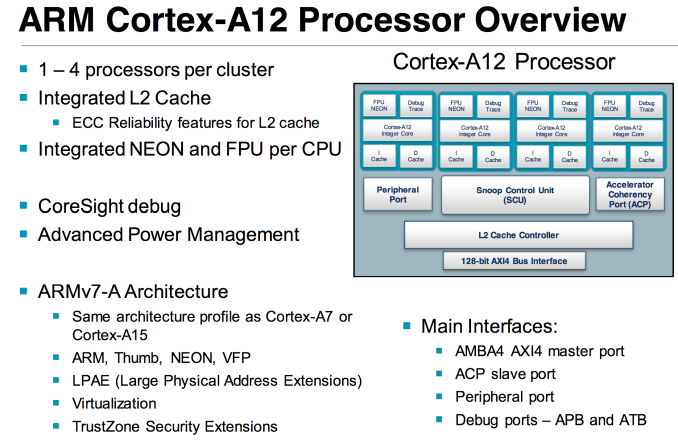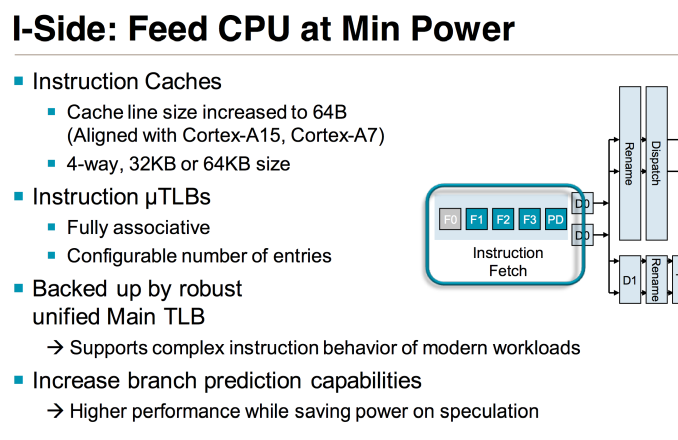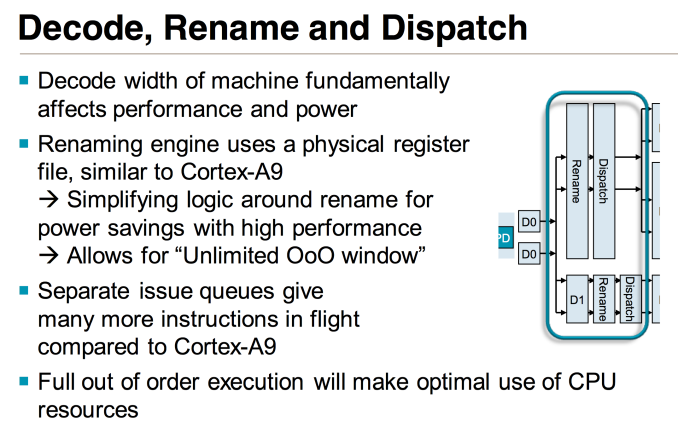The ARM Diaries, Part 2: Understanding the Cortex A12
by Anand Lal Shimpi on July 17, 2013 12:30 PM EST- Posted in
- CPUs
- Arm
- SoCs
- Cortex A12
Introduction to Cortex A12 & The Front End
At a high level ARM’s Cortex A12 is a dual-issue, out-of-order microarchitecture with integrated L2 cache and multi-core capable.
The Cortex A12 team all previously worked on Cortex A9. ARM views the resulting design as not being a derivative of Cortex A9, but clearly inspired by it. At a high level, Cortex A12 features a 10 - 12 stage integer pipeline - a lengthening of Cortex A9’s 8 - 11 stage pipeline. The architecture is still 2-wide out-of-order, but unlike Cortex A9 the new tweener is fully out of order including load/store (within reason) and FP/NEON.
Cortex A12 retains feature and ISA compatibility with ARM’s Cortex A7 and A15, making it the new middle child in the updated microprocessor family. All three parts support 40-bit physical addressing, the same 128-bit AXI4 bus interface and the same 32-bit ARM-v7A instruction set (NEON is standard on Cortex A12). The Cortex A12 is so compatible with A7 and A15 that it’ll eventually be offered in a big.LITTLE configuration with a cluster of Cortex A7 cores (initial versions lack the coherent interface required for big.LITTLE).
In the Cortex A9, ARM had a decoupled L2 cache that required some OS awareness. The Cortex A12 design moves to a fully integrated L2, similar to the A7/A15. The L2 cache operates on its own voltage and frequency planes, although the latter can be in sync with the CPU cores if desired. The L2 cache is shared among up to four cores. Larger core count configurations are supported through replication of quad-core clusters.
The L1 instruction cache is 4-way set associative and configurable in size (32KB or 64KB). The cache line size in Cortex A12 was increased to 64 bytes (from 32B in Cortex A9) to better align with DDR memory controllers as well as the Cortex A7 and A15 designs. Similar to Cortex A9 there’s a fully associative instruction micro TLB and unified main TLB, although I’m not sure if/how the sizes of those two structures have changed.
The branch predictor was significantly improved over Cortex A9. Apparently in the design of the Cortex A12, ARM underestimated its overall performance and ended up speccing it out with too weak of a branch predictor. About three months ago ARM realized its mistake and was left with the difficult situation of either shipping a less efficient design, or quickly finding a suitable branch predictor. The Cortex A12 team went through the company looking for a designed predictor it could use, eventually finding one in the Cortex A53. The A53’s predictor got pulled into the Cortex A12 and with some minor modifications will be what the design ships with. Improved branch prediction obviously improves power efficiency as well as performance.














65 Comments
View All Comments
wumpus - Thursday, July 18, 2013 - link
Most of the analysis of MIPS implies that it has a chance at the embedded world, but not a prayer where the chips listed in this article play. I would assume that Imagination has a long term plan to break into this market, but it will take some sort of extreme cost/power/performance advantage to convince anyone to give up an architecture. There is a reason that ARM64 is still a dominant architecture, and it has nothing to do with any inherent superiority of the instruction set (indeed, it is a disaster and an unholy kludge. While most of the time "the backward stuff" might be irrelevant to modern computing, it still takes up area, has to be validated, and still has warts that have to be dealt with every design). Changing architectures isn't taken lightly (see how wonderfully windows RT is doing).Qwertilot - Thursday, July 18, 2013 - link
Isn't the business model the major reason for the architecture getting so dominant? Given how cheaply/freely they license the architecture, you need a really strong motivation and/or massive scale to consider using anything else. Limits ARMs size of course.Mondozai - Friday, July 19, 2013 - link
"There is a reason that ARM64 is still a dominant architecture, and it has nothing to do with any inherent superiority of the instruction set"Sorry that's just lazy.
ARM is where it is because no comptetitor has managed an alternative that is sufficiently competitive to their architecture.
Legacy isn't an issue. If ARM was going irrelevant, the switch would occur, and very fast too.
fteoath64 - Friday, July 19, 2013 - link
Qualcomm is not worried right now because it is busy with serving higher priced solutions and it could hardly supply those customers!. Besides, Qualcomm has access to next-gen process in volumes that can crush MediaTek , Actions, HiSilicon etc by dropping prices in the next-gen offerings. That market will run out for MediaTek within 12 months, so Qualcomm is playing the game right for now. All ARM licensees can do whatever they want as long as they stay within their contractual obligations. These Chinese licensees better be careful les they get cut off from the license and had to seek alternative architectures (meaning none, what going Intel is suicide!). The idea of MediaTek and others taking the "lower-tier" of the market for 3-4 quarters is enough for all to feast on the market. They do not want Intel to come in to cream everything off and leaves nothing for the partners to live on. There is strategy and turf protection, these are no dumb companies having made it this far. They know most of the tricks and can outwit the or else they will die. You should know the difference between Chinese vendors and western vendors, the Chinese manufacturers are happy to sell a wholesaler a phone for $110 when it cost them $80 to make. ie profit $30. The wholesaler turns around and sell it for $180 making $40-50 each after all the distribution costs etc. Western companies will see this unit for $300 retail!. The difference is greed even when the manufacturer provided goodwill in the factory price. The reason factories put a limited profit on each unit is to move the volumes because they know full well what the market price is going to be. They do not want to inflate it further.lilmoe - Thursday, July 18, 2013 - link
I'm sure you have valid points too, but you're not getting my side of the story. MediaTech's solution is pretty solid, yes, but it's strictly Cortex A9. Consumer demand, even in developing countries, is growing, and the need for faster chips is growing as well. By 2015, what makes you think that Krait wont be competitive in price with higher performance? Qualcomm needs only to re-badge their already developed chips with higher clock speeds.Profit margins are way higher in developed countries, it's just a matter of time that even current flagship devices be slashed in price (with a slight change in design and chassis) and they're ready to take on the cheapest Chinese OEMs have to offer...
Anyway, this doesn't change the fact that ARM made a mistake in its priorities. Cortex A15 (big.LITTLE) should have been targeted for 20/22nm and smaller processes. Priority should have been for Cortex A12. And yes, flagships (hero phones) could have made use of that core if it was ready by this time, especially since it could have competed really well with Krait in both power efficiency and performance (most probably beating it if ARM's claims are to be believed in that regard.
Qwertilot - Thursday, July 18, 2013 - link
The world, and A15 in particular, isn't just mobile phones :) The Samsung Chromebook, early versions of the micro server hardware, shield aren't all massive volume but they've started the process of starting to get Arm chips accepted in a bunch of device classes where they just didn't previously exist.(Phone wise it did end up powering a lot of S4's.).
You can see that could easily be more attractive/important as a priority for ARM than picking fights with existing licensees over high end mobile phones.
If Qualcomm/ (Intel too of course) end up directly taking on the cheapest that the Chinese OEMs have to offer they've basically already lost as there's then so little profit left. They have to somehow make the case for more expensive but also more powerful/efficient chips. At some point that'll get hard.
lilmoe - Thursday, July 18, 2013 - link
True, it isn't only for mobile devices (smartphones and tablets), but those make the absolute majority of demand. ARM has too much competition to face in the server world, a world that already has tons of existing x86 code. By the time they're ready to seriously fight in the server world, 14nm would be the norm.Again, my argument isn't about which chip goes where, or who should compete where, it's about timing and priorities of architecture designs, which ARM clearly screwed up on. At least that's how I see it.
Mondozai - Friday, July 19, 2013 - link
lilmoe wrote:"By 2015, what makes you think that Krait wont be competitive in price with higher performance? Qualcomm needs only to re-badge their already developed chips with higher clock speeds."
And what makes you think that the competition will stand still until that time?
They could get better SoC's based on the A-12 by that time, to just name one (out of many) possibilities.
lilmoe - Friday, July 19, 2013 - link
They WILL stand still because Cortex A12 isn't ready to ship yet. It'll be a good 2 years before it's "cheaply" manufactured by the likes of MediaTec.By the way, Krait powered Nokia Lumias are going for around and less than the $200 mark right now. People are forgetting that Android isn't the only contender in the market. OS market share will most probably look very different in 2015.
There are many dynamics running the low power processor market.
Wilco1 - Wednesday, July 17, 2013 - link
It's only late if you consider it a directly competitor of Silvermont. However A9R4 as used by Tegra 4i seems perfectly timed.